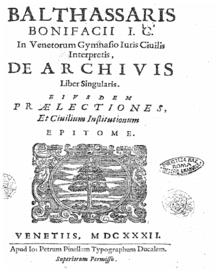Baldassarre Bonifacio
Baldassarre Bonifacio (5 January 1585 - 17 November 1659) was an Italian Catholic bishop, theologian, scholar and historian, known for his work De archivis liber singularis (1632), the first known treatise on the management of archives.[1]
Baldassarre Bonifacio | |
|---|---|
| Bishop of Koper | |
Memorial plaque of Msgr. Baldassarre Bonifacio (Chiesa della Beata Vergine del Soccorso, Rovigo) | |
| Church | Catholic Church |
| Diocese | Diocese of Koper |
| Appointed | 23 November 1653 |
| Term ended | 17 November 1659 |
| Predecessor | Pietro Morari |
| Successor | Francesco Zeno |
| Orders | |
| Consecration | 30 November 1653 (Bishop) by Marcantonio Bragadin |
| Personal details | |
| Born | 5 February 1585 Crema |
| Died | 17 November 1659 (aged 74) Koper |
Biography
The son of a lawyer of the same name, Bonifacio was born at Crema, in the Republic of Venice on January 5, 1585.[2] In his thirtieth year he went to study at Padua, and made such proficiency as to be created doctor of laws at the age of eighteen. About two years after he was appointed law professor in the college of Rovigo, where he first lectured on the Institutes of Justinian.
He afterwards accompanied Count Girolamo di Porzia, bishop of Adria and papal nuncio, to Germany as his private secretary, and was himself employed in some affairs of importance.[2] On his return to Venice, he had several preferments, and among others that of archpriest of Rovigo. In October 3, 1619, he was elected Greek and Latin professor at Padua, but declined accepting the office.
In 1620, he assisted at Venice, in the establishment of an academy for the education of the young nobility and gave lectures on the civil law. Pope Urban VIII bestowed on him the archdeaconry of Treviso, which he held, with the office of grand vicar of that diocese, under four successive bishops. He assisted also very essentially in founding a new academy at Padua for the Venetian nobility, in 1636, and was the first director or president of it, and founded a similar establishment at Treviso.
In 1653 he was appointed bishop of Koper, which he held until his death in 1659. He was a man of various learning, as appears by his Historia Trevigiena 4to, his Historia Ludicra (1656) 4to, a collection of singular narratives from authors of every description. He published also some Latin poems in 1619, 12mo and De Romanæ Historiae Scriptoribus excerpta ex Bodino Vossio et aliis, Venice, 1627, 4to.
Throughout his life Bonifacio maintained many friendly relationships with numerous intellectuals of his age and was a member of many academies (Umoristi, Incogniti, Olimpici, Filarmonici).[2]
Works

- Castore e Polluce. Rime di Baldassarre Bonifaccio, e di Gio. Maria Vanti, Venice, appresso Francesco Prati, 1618 in 12°;
- Balthassaris Bonifacii Stichidion libri XVIII, Venetiis, apud Pratum, 1619, in 16°;
- Bonifacij Musarum pars prima, Venice, apud Ioannem Iacobum Hertium, 1646, in 8°;
- Dell'immortalità dell'anima, discorso di Baldassare Bonifaccio, Venice, appresso Antonio Pinelli, 1621, in 4°;
- Risposta al manifesto della Signora Sarra Copia, Venice, appresso Antonio Pinelli, 1621;
- Amata: tragedia di Baldassare Bonifaccio, Venice, appresso Antonio Pinelli, 1622, in 8°;
- Caroli Sigonii Iudicium de historicis, qui res romanas scripserunt, ab Vrbe condita ad Caroli Magni imperatoris tempora. Accesserunt de eisdem scriptoribus Excerpta a Balthassare Bonifacio, et Ordo Romanæ historiæ legendæ Adriani Politi, Venice, apud Antonium Pinellum, 1627 in 4°; Helmstadt 1674 in 4°;
- Historia ludicra. Opus ex omni disciplinarum genere, selecta et Jucunda eruditione refertum, Venice, apud Paulum Baleonium, 1652 in 4°; Bruxelles, Joan. Mommartius, 1656;
- De Archivis liber singularis. Ejusdem Praelectiones et Civilium Institutionum Epitome, Venice, Apud J.P. Pinellium, 1632, in 4°
- Balthassaris Bonifacii Conjecturæ in Martialem. Ejusdem Polynesi origines, Venice, ex typographia Pinelliana, 1635.
- Epistolae duae de majoribus Venetorum comitiis et judiciis capitalibus, altera ad Jo. Franciscum Corneanium altera ad Dominicum Molinum. Published by Pieter Burman in the fifth volume of his Thesaurus Antiquitatum et Historiarum Italiae, Lugduni Batavorum, 1722.
References
- Duchein, Michel (1992). "The History of European Archives and the Development of the Archival Profession in Europe". The American Archivist. 55 (1): 16. doi:10.17723/aarc.55.1.k17n44g856577888.
- Giorgetta Bonfiglio Dosio (2019). "Baldassarre Bonifacio". In Luciana Duranti; Patricia C. Franks (eds.). Encyclopedia of Archival Writers, 1515 - 2015. Rowman & Littlefield. p. 58.
Bibliography
- Lester K. Born, Baldassare Bonifacio and his Essay de Archivis, «The American Archivist»,4/4 (1941), p. 221-237
- Chalmers, Alexander (1812). The General Biographical Dictionary: Containing an Historical and Critical Account of the Lives and Writings of the Most Eminent Persons in Every Nation, Particularly the British and Irish, from the Earliest Accounts to the Present Time. Nichols.

- Nicéron, Jean-Pierre (1731). "Bonifacio (Balthazar)". Memoires pour servir a l'histoire des hommes illustres dans la republique des lettres (in French). 16. Paris: Briasson. pp. 366–378.
- Rossi, Lovanio (1970). "BONIFACIO, Baldassarre". Dizionario Biografico degli Italiani, Volume 12: Bonfadini–Borrello (in Italian). Rome: Istituto dell'Enciclopedia Italiana.
- Michaud, Joseph François; Michaud, Louis Gabriel (1812). "Bonifacio (Balthazar)". Biographie universelle, ancienne et moderne (in French). 5. Paris: Michaud frères. pp. 117–120.